“WINDJAMMER” to set sail soon in a new digital version |
Read more at in70mm.com The 70mm Newsletter |
| Written by: Randy Gitsch, Producer Cinerama / Cinemiracle Remaster / Restoration | Date: 25.08.2017 |
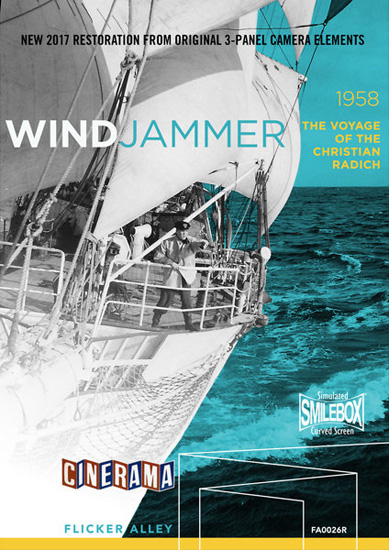 “WINDJAMMER: THE VOYAGE OF THE CHRISTIAN
RADICH” to set sail soon in a new digital version. Widescreen film fans
around the world will be thrilled to hear that a new, sharper, clearer
version of the 1958 three-panel picture has now been created by the Cinerama
Restoration Team. Its theatrical rollout is now nearing its kick-off and
will lead to a new Blu-ray launch next spring. “WINDJAMMER: THE VOYAGE OF THE CHRISTIAN
RADICH” to set sail soon in a new digital version. Widescreen film fans
around the world will be thrilled to hear that a new, sharper, clearer
version of the 1958 three-panel picture has now been created by the Cinerama
Restoration Team. Its theatrical rollout is now nearing its kick-off and
will lead to a new Blu-ray launch next spring.Cinerama restorationist David Strohmaier previously re-mastered the triptych, digitally marrying the three film panels into one digital 16x9 panorama, and Smileboxing® the end results in 2011. Along with his re-mastered version of the inaugural Cinerama release, “THIS IS CINERAMA” they became the first two widescreen classics from the Cinerama vaults to be re-launched to theatrical venues in 45 years, and the first to be marketed to home video markets. That 2K composite version from 6K worth of scans (2K from each of the three panels) was well received despite its’ visual shortcomings. It had been made from an anamorphic 35mm print of a photographed projected performance of the picture. This process was conceived and overseen by Hollywood technical pioneer Linwood Dunn in the early 1970’s to provide Cinerama Inc. with a low cost, single-panel version of the original triptych. It bore many imperfections, such as on-camera rack focusing, or timely lack of it, and on-the-fly frame adjustments. It also hosted the inherent color shift, fade miss-matched between the panels, embedded dirt, accumulated scratches and rocky sprocket hole chatter of its’ 12-year-old source prints. The resultant capture, with these faults, was at best, only a dupe of a dupe. Another 41 years passed before Strohmaier got modest funding to begin re-mastering the title, using this as its’ most accessible picture source. Despite those visual shortcomings, enthusiastic fan-based reception of it led to a re-financed Strohamier being made able to tackle this new version by accessing the picture’s Interpositive and in places where that was impossible due to IP wear, the original camera negative of the picture. Strohmaier now estimates his final assembly was created with 60% coming from the IP, and 40% from the OCN. Now harkening back to the picture’s original 1958 Harrision’s Reports Exhibitors trade journal reaction, the results of this new version are “nothing short of magnificent”. Colors are now more saturated and vibrant. The three panels are now more closely matched in color, and often, very often, the expansive picture is seamless. But most importantly, the picture is now clearer, so clear in fact that rigging lines on the ship and expressions on faces are now more realistic and pleasing. But even visual minutiae like buttons on shirts and laces on shoes are now omnipresent and relevant. From what had at times in the 2011 version seemed like animated painting, a true documentary motion picture has now emerged with all the clarity of the Cinemiracle three lens capture. This is the way the picture looked in 1958. Compare these 2011 frame grabs to the new 2017 version. The results are startling… |
More in 70mm reading: Major restoration of “WINDJAMMER: THE VOYAGE OF THE CHRISTIAN RADICH” at the Cinerama Dome, Saturday April 28, 2018 2017: Flicker Alley presents "This is Cinerama" and "Windjammer: The Voyage of the Christian Radich" 2017 Authorized Restorations in70mm.com's "Windjammer" in Cinemiracle page 2011:"Windjammer" Blu-ray Cinerama Remaster PDF: "Windjammer" Flyer Randy Gitsch David Strohmaier Tom March Internet link: |
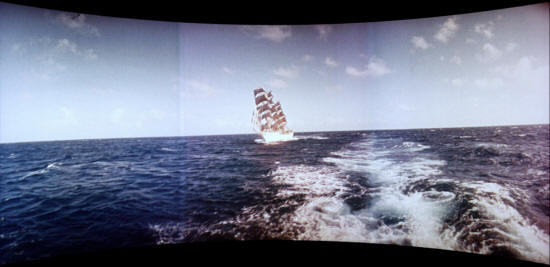 SHOT 1. - The Christian Radich Mid-Atlantic
Under Sail SHOT 1. - The Christian Radich Mid-Atlantic
Under Sail1A-2011 Version-Notice the general murkiness as the blue in the sky is minimal, and the sea is nearly black. The blue overall is very thin here. Notice too the ship is very hot and has no detail. You can see sails but no riggings. Note that the whitewater churn from the camera boat is very flat on the surface of the water. The “Baker panel”, or “B”, in the center of the frame appears pinker than the panels on either side of it. The effect of the whole looks more like a painting than a photograph. |
|
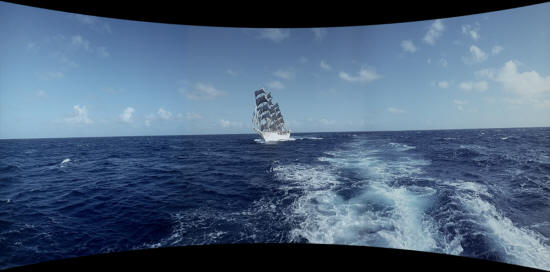 1B-2017 Vers.-Now a much more pleasing image, with the blue record better
established in both the sky and the water. Although the white ship is being hit
broadside by the sun, if you move in on the image, you can now see portholes and
riggings to the sails. The whitewater churn now has dimension and you can sense
the spray above the sea surface. The wavelets are now detailed and the horizon
line is more realistically sharp. The three panels are uniform and only slightly
discernable from one another. Note there is no grain in Cinerama/Cinemiracle.
Three pieces of film create the size. No blow-up is necessary. 1B-2017 Vers.-Now a much more pleasing image, with the blue record better
established in both the sky and the water. Although the white ship is being hit
broadside by the sun, if you move in on the image, you can now see portholes and
riggings to the sails. The whitewater churn now has dimension and you can sense
the spray above the sea surface. The wavelets are now detailed and the horizon
line is more realistically sharp. The three panels are uniform and only slightly
discernable from one another. Note there is no grain in Cinerama/Cinemiracle.
Three pieces of film create the size. No blow-up is necessary. |
|
 SHOT 2. - Looking up hill along the Rio de Santa Luzia from intersection of
Rio do Pombal as Basket Sled passes old Seminary Bldg./Funchal, Madeira SHOT 2. - Looking up hill along the Rio de Santa Luzia from intersection of
Rio do Pombal as Basket Sled passes old Seminary Bldg./Funchal, Madeira2A-2011 Version – Note the overall lack of detail and muting of color. The wall on the right in C panel has no texture. The passengers in the basket sled have no facial features, and you’re not able to tell what one may be holding. The activity in the street, further up the hill and behind the basket sled is indistinct. The cobblestone street looks painted. |
|
 2B-2017 Vers. Now the shot comes alive with greater clarity and interest. The
cobblestones are distinct and a manhole cover is seen to the far left, in the
previously missing area. The white wall to the right isn’t white at all. It’s a
dusty pink. The trio in the basket sled appear to be a mother (and I can see
she’s wearing glasses), daughter, and father, now visibly holding a camera in
his lap. His necktie is swirling. Now you can see shutters in the windows of the
bldg. on the left. And behind the sled, you can now see a jeep with two men to
its left side and a third to its right, carrying a basket on his shoulders.
Notice the garden to the far right behind the seminary. Can you see the flowers? 2B-2017 Vers. Now the shot comes alive with greater clarity and interest. The
cobblestones are distinct and a manhole cover is seen to the far left, in the
previously missing area. The white wall to the right isn’t white at all. It’s a
dusty pink. The trio in the basket sled appear to be a mother (and I can see
she’s wearing glasses), daughter, and father, now visibly holding a camera in
his lap. His necktie is swirling. Now you can see shutters in the windows of the
bldg. on the left. And behind the sled, you can now see a jeep with two men to
its left side and a third to its right, carrying a basket on his shoulders.
Notice the garden to the far right behind the seminary. Can you see the flowers? |
|
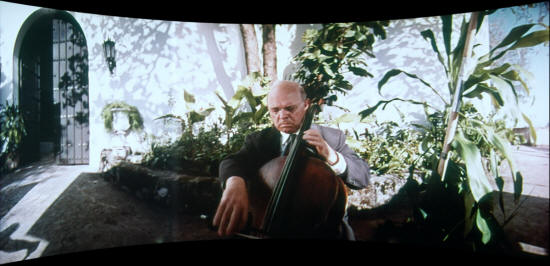 SHOT 3. – Pablo Casals performs “Song of the Birds” in a garden at La
Fortaleza/San Juan, Puerto Rico SHOT 3. – Pablo Casals performs “Song of the Birds” in a garden at La
Fortaleza/San Juan, Puerto Rico3A-2011 Version – This shot is very murky with an over-abundance of black. There is no detail in the shadows. Casals is wearing glasses although there’s no distinct detail to them. You can’t see the strings of Casal’s bow touching the strings of his cello. It may appear to you that Casals is photographed in front of a flat wall. The join line between panels “A” and “B” is noticeable due to a white vertical banding. |
|
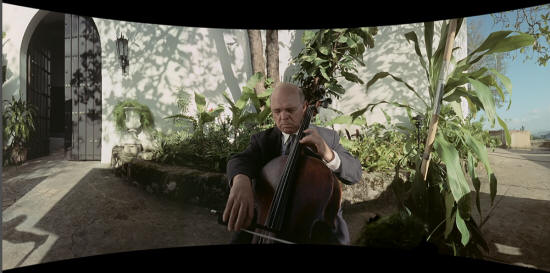 3B-2017 Vers. Violá! Now the shot comes alive to the sound of his playing. You
can see the strings of his bow. You can make out the fine wire frames of his
glasses. You can see that he’s sitting under an umbrella, because he’s adjacent
to an aluminum-banded support pole of one. The picture panel join has now been
minimized. The wall behind him has an angle to it. And now in the additionally
visible area to the far right, you can now glimpse the Bahia de San Juan. 3B-2017 Vers. Violá! Now the shot comes alive to the sound of his playing. You
can see the strings of his bow. You can make out the fine wire frames of his
glasses. You can see that he’s sitting under an umbrella, because he’s adjacent
to an aluminum-banded support pole of one. The picture panel join has now been
minimized. The wall behind him has an angle to it. And now in the additionally
visible area to the far right, you can now glimpse the Bahia de San Juan. |
|
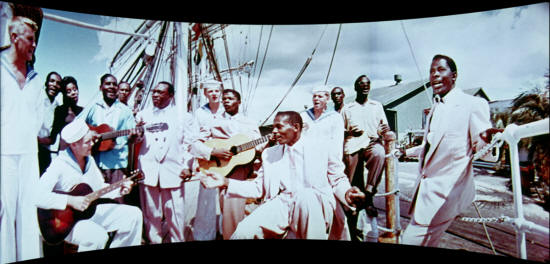 SHOT 4. – Christian Radich sailors jam with Mighty Skipper, Mighty Viper,
Lord Superior & Al Thomas to sing calypso “Don’t You Hurry, Worry
Me”/Port-of-Spain, Trinidad SHOT 4. – Christian Radich sailors jam with Mighty Skipper, Mighty Viper,
Lord Superior & Al Thomas to sing calypso “Don’t You Hurry, Worry
Me”/Port-of-Spain, Trinidad4A-2011 Version – This shot would have proved very difficult even for a Hollywood studio to shoot. But the “Windjammer” production crew, under the helm of veteran Louis de Rochemont, were documentarians. They had only shiny boards to reflect light. So in this shot they had pale-skinned blond Norwegian sailors wearing white, to film outdoors, under a white cloudy sky, and standing adjacent to very dark-skinned Trinidadians. The result here in our original dupe-of-a-dupe source is that everything is blown. To have digitally adjusted one direction to give the sailors more shadow detail, would have left the Trinidadians with only teeth and eyes for features. To have lightened the shot to see the faces of the dark skinned musicians would have made the Norwegians look like Kabuki. The result is the worst shot in the 2011 version film. |
|
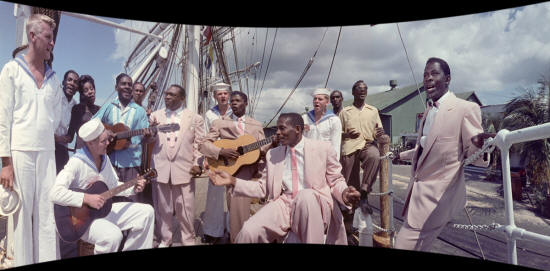 4B-2017 Vers. – A remarkable improvement. Notice the sailor on the left is
holding his cap, previously missing in the cropped version. The color balance is
now restored. Even we were shocked. The Trinidadians suits and ties are subtle
pink. Everyone has features, They’re real. The musician on the far right has a
gold tooth. 4B-2017 Vers. – A remarkable improvement. Notice the sailor on the left is
holding his cap, previously missing in the cropped version. The color balance is
now restored. Even we were shocked. The Trinidadians suits and ties are subtle
pink. Everyone has features, They’re real. The musician on the far right has a
gold tooth. |
|
|
The whole film is now this beautifully revitalized and refreshing. “WINDJAMMER: THE VOYAGE OF THE CHRISTIAN RADICH” is a one-of-a-kind true-life adventure following the trans-Atlantic journey of a crew of young sailors-in-training. Their 17,500 mile-long journey became the basis for the only film ever shot in the Cinemiracle widescreen process, itself a refinement of the tremendously poplular Cinerama system, which was the 1950’s pre-cursor to IMAX. From a DCP source created by Cinerama Aficionado and longtime Cinerama Restoration Team contributor Tom March, Strohmaier and restoration producer Randy Gitsch will premiere the new digital version of the picture at Bradford, Yorkshire’s Widescreen Weekend festival event held in the National Media Museum’s famed Pictureville Cinema. That screening is set for Friday, October 13, 2017, on Pictureville’s curved screen. Dave and Randy have premiered 6 of their remastered Cinerama triptychs in Pictureville. They have now finished work on all of the 3-panel and 70mm features and shorts in the Cinerama library, a total of 15 titles. Other European screening plans are actively underway now. Cinerama Restoration Team members Thomas Hauerslev and Anders Olson are readying new foreign-language subtitle tracks for various territories to accompany theatrical screenings almost anywhere. So as the original print advertising for the picture touted, first time viewers and returning fans can now look forward to knowing, “The Day You’ll Never Forget is the Day You See Windjammer”. |
|
| Go: back - top - back issues - news index Updated 22-01-25 |
